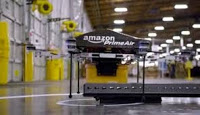 |
| image source |
Nicholas West
Activist Post
Yesterday Eric Blair wrote about how autonomous vehicles are set to populate not only roads as self-driven cars, but to take over the entire supply line from manufacture to delivery. The outsourcing of humans to robots continues unabated as some experts expect a complete elimination of the need for a human workforce by 2045.
The Internet absolutely blew up yesterday with reports of America’s largest online retailer, Amazon.com, researching the move to a drone delivery platform called Prime Air.
The announcement from CEO Jeff Bezos has spurred an element of disdain and humor about the proposal. Here is a parody of what Amazon’s UK competitor, Waterstones, proposes in response:
However, it seems that Amazon is taking the project quite seriously. Similar to the discovery of surveillance drones back in 2007, there appears to be a bit of nervous laughter attempting to dismiss the entrance of commercial drones into U.S. airspace. Nevertheless, the trend toward automated delivery systems, coupled with drones being embraced fully by Congress to fly in U.S. airspace by 2015 demands a closer look at the potential transformation of the economy.
The drone industry in general is a booming one across the globe. Already used for surveillance and targeted killing, drones have also been embraced by the media as a less expensive way to capture video footage for their reports. Other commercial applications include real estate and agriculture. Meanwhile, drone enthusiasts have been at work on DIY person-to-person drone delivery systems. After all, who could forget Domino’s PR pizza delivery stunt with their DomiCopter?
In fact, Amazon is far from the first to invest in the concept, but they are by far the biggest. While Waterstones might mock the idea of book delivery, it’s already been developed in Australia.
Australian textbook rental company Zookal has partnered with Flirtey, a commercial drone service, to ship some Australian students their books just minutes after they place an order. (Source)
Here is how it is envisioned to work:
A user makes a purchase on his or her smartphone, and selects Flirtey as the delivery method of choice. Back at headquarters, a human packs up the purchased items — although Zookal hopes to automate the packing in the future — and attaches it to the drone. A few minutes later, the drone and your package arrive.
Total time from submitting an order to having the book in your hand: two or three minutes, Haider said.
Flirtey can deliver packages to any outdoor space, including doorsteps, backyards, street corners and even balconies.
At first, the drones will be able to deliver books within a kilometer radius (about 0.6 miles) from a dispatch center, but Haider said that as the team improves the technology, he hopes to increase delivery distance to five or 10 kilometers (three to six miles).
Flirtey has been tested in the area around Zookal’s Sydney headquarters, but will become an option for customers located in many Australian cities, since Zookal has operations nationwide.
Australian students will be able to choose drone delivery starting in March 2014. Zookal plans to test the drones in Asian markets before bringing them to the United States in 2015. (emphasis added)
The target date of 2015 is an interesting one, as you’ll remember above that it’s the exact date where drones are expected to gain widespread approval for flights inside the United States. The video report below about Jeff Bezos’ announcement on 60 Minutes for his target date acknowledges the hurdle, as well as an integration time that could extend 4-5 years beyond that.
As also noted in the report, tech writers are not as dismissive of the concept as Amazon’s competitors or some of the general public making statements on Twitter and other social media. One might doubt how Amazon could deliver its vast array of products in any practical way, especially those at higher weight levels, but 86 percent of Amazon’s business is items 5 pounds or less, which makes the plan for fleets of small, light “octocopters” feasible enough that Bezos stated emphatically, “It will work and it will happen, and it’s gonna be a lot of fun.” (Source)
The surge in company development of autonomous transportation highlighted at the beginning of this article is a major game changer when one takes into account the potential elimination of a massive amount of human employment that currently transports consumer goods into the hands of buyers. Tech site GIGAOM also emphatically titled a recent article, “Consumer drones are coming, and they will change everything.” Despite listing the main concerns: namely, potential frequent crashes and invasion of privacy, writer Signe Brewster feels that the technology is too attractive and transformative not to explore.
 Environmental benefits are also being touted, no doubt to introduce further economic and political acceptance.
Environmental benefits are also being touted, no doubt to introduce further economic and political acceptance.
“It’s very green,” Bezos said. “It’s better than driving trucks around.”
That’s probably not a position shared by the vast number of truck drivers employed, however. Yet, as Business Week explains, this concept is one that would satisfy customers as well as shareholders, while fully embracing the growth in e-commerce; a tough combination of benefits for any company to ignore:
The company invests heavily in distribution and delivery, which made up the largest portion of Amazon’s expenses in the third quarter. Investors have endorsed the spending on capacity — the costs increased 35 percent to $2.03 billion — pushing up the company’s shares 57 percent so far this year even as it posts losses.
The company had 89 warehouses in 2012 and is planning 7 more this year. Amazon also unveiled plans in July to increase staff by 5,000 in 17 centers this year and is hiring 70,000 seasonal workers in the U.S. to meet holiday order demand.
Bezos showed the drones as the growth of e-commerce sales outstrips total retail sales. On Black Friday, e-commerce spending increased 15 percent to a record $1.2 billion as more consumers opted to shop from their couches rather than battle long lines at stores, according to ComScore Inc. (Source)
Another selling point is being explored by Matternet, a company interested in bringing a vast global connectivity via drones, similar to the Internet. Employing the tagline “drones are good” CEO Andreas Raptopolous gave a TED lecture where he highlighted the inherent access and low cost of drone delivery:
Instead of packets of information, Matternet will transport goods using a network of autonomous electric drones, landing stations, and an operating system to keep it all running.
Drones would deliver medicine in developing countries with poor road infrastructure, in urban environments, even after natural disasters. Matternet estimates they can move two kilograms 10 kilometers for just $0.24. (Source)
Whenever we see a merger of political will, consumer interest in receiving products as fast as possible, and now a mega company like Amazon coming to the fore to offer logistics of how this service will make the lives of all Americans more convenient, it’s definitely no laughing matter. Add in a bit of feel-good, and the PR push is on to welcome drones as a part of everyday life.
It’s worth concluding with the same must-see documentary that Eric Blair concluded his article with yesterday. Whether or not Amazon’s specific program can manage to overcome the physical safety issues, autonomous delivery systems and robotics pose a very real threat to the livelihood of human beings who aren’t prepared for the future economy. Here is what you need to know in order to stay relevant ….
Please also review these 3 recent articles that encompass the impact of drones and robotics:


Be the first to comment on "Delivery Drones to Usher in Economic Transformation"